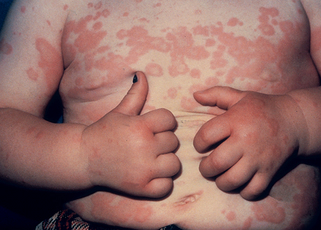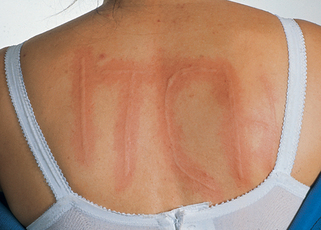Chapter 23 Urticaria and angioedema
1. What percentage of the population experiences acute urticaria during their lifetime?
2. How is acute versus chronic urticaria defined?
Classification of urticaria begins with duration and frequency of the rash. Although arbitrary, 6 weeks of nearly daily symptoms has been chosen as the dividing point for differentiating between acute and chronic urticaria.
Ormerod AD: Urticaria: recognition, causes, and treatment, Drugs 48:717–730, 1994.
4. Are all urticarial reactions from medications allergic (IgE-mediated) in nature?
No. Some medication reactions may not be truly allergic but may be caused by nonspecific mast cell–releasing or anaphylactoid properties. Common drugs with this mechanism of action include opiates, vancomycin, radiocontrast media (especially, high-osmolar, ionic forms), and nonsteroidal antiinflammatory drugs.
7. How common are the physical urticarias?
Of 554 patients with urticaria seen in a university clinic in England, physical urticarias constituted 17.5% of the total; most of the remainder were idiopathic. The most frequent of the physical urticarias were dermographism (8.5%) (Fig. 23-2), cholinergic urticaria (5.1%), and acquired cold urticaria (2.5%).
8. What association has been described between autoantibodies and chronic urticaria?
In two studies, antithyroid microsomal antibodies have been reported in 12% to 14% of patients with chronic urticaria; however, thyroid status did not relate to the occurrence of urticaria and typically hives did not revert when a euthyroid state was achieved. A number of patients with chronic urticaria react to intradermal injection of their own serum by developing a wheal and flare that persists up to 8 hours. Many of these patients have IgG antibodies in their serum that react with the alpha subunit of the high-affinity IgE receptor on mast cells and basophils. In other patients, the IgG antibody appears to react with IgE itself. The frequency of these IgG autoantibodies in patients with chronic urticaria is not yet established but has been reported to be as high as 40% and 10%, respectively, in a referral clinic.
Tong LJ, Balakrishnan G, Kochan JP, et al: Assessment of autoimmunity in patients with chronic urticaria, J Allergy Clin Immunol 99:461–465, 1997.
9. What is the “triple response”? Name the components.
10. What is the mechanism of the axon reflex?
The axon reflex is produced by stimulation of cutaneous sensory nerve endings, with antidromic conduction of the impulse and release of the neurokinin substance P. Substance P is a vasodilator and it also causes the release of histamine and other mediators from cutaneous mast cells, thus augmenting the urticarial reaction.
11. List five mediators that are capable of directly causing vasodilatation and increased vascular permeability in the skin.
12. Name three mediators that may cause vasodilatation and increased vascular permeability indirectly through action on the mast cell.
Stay updated, free articles. Join our Telegram channel

Full access? Get Clinical Tree










